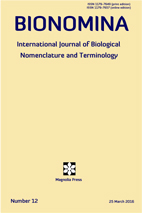Abstract
Though taxonomic studies provide basic information about the diversity of life, they are often impeded by unfounded beliefs, anthropomorphic feelings, inadequate information of decision holders, and threatened by the activities of some zoologists and conservationists. Two such threats are discussed. One is latent, derived from the provisions of the International Code of Zoological Nomenclature. The second is actual/effective, caused by technocratic restrictions limiting field work. The present trends lack a rational foundation, are counterproductive and risk producing negative impacts on efforts to extend conservation of natural sites.
References
Anonymous [International Commission on Zoological Nomenclature] (1999) International code of zoological nomenclature. Fourth edition. London (International Trust for zoological Nomenclature): i–xxix + 1–306.
Borkhausen, M. B. (1797) Deutsche Fauna oder kurzgefasste Naturgeschichte der Thiere Deutschlands. Erster Theil. Säugerthiere und Vogel. Frankfurt am Main: i–xxiv + 1–620. <https://doi.org/10.5962/bhl.title.58727>.
Carbonnel, J.-P. & Moeschler, P. (2001) Petite contribution au problème de la protection de l’entomofaune. Le Coléoptériste, 42: 91–94.
Costello, M. J., May, R. M. & Stork, N. E. (2013) Can we name earth’s species before they go extinct? Science, 339: 413–416. <https://doi.org/10.1126/science.1230318>.
Dubois, A. (2017) The need of reference specimens in zoological taxonomy and nomenclature. Bionomina, 12: 4–38. <https://doi.org/10.11646/bionomina.12.1.2>.
Geiser, E. (1988) Der Entomologe – ein Schädling oder ein Nützling? Quantitative und qualitative Überlegungen zu den Artenschutzverordnungen. Natur und Land, 1: 2–8.
Gepp, J. (1973) Kraftfahrzeugverkehr und fliegende Insekten. Natur und Landschaft, 59: 127–129.
Illies, I. & Mühlen, W. (2007) Late blooming lime trees (Tilia spec) (Hymenoptera: Apidae) [Das Sammelverhalten von Honigbienen an spätblühenden Linden]. Entomologia generalis, 30: 155–165.
Kemp, C. (2015) The endangered dead. Nature, 518: 292–294. <https://doi.org/10.1038/518292a>.
Klausnitzer, B. (2000) Entomofaunistik an der Schwelle zum 3. Jahrtausend. Entomologica basiliensia, 22: 61–74.
Marshall, S. A & Evenhuis, N. L. (2015) New species without dead bodies: a case for photo-based descriptions, illustrated by a striking new species of Marleyimyia Hesse (Diptera, Bombyliidae) from South Africa. Zookeys, 525: 117–127. <https://doi.org/10.3897/zookeys.525.6143>.
Popper, K. (1959) The logic of scientific discovery. London (Hutchinson): 1–513. <https://doi.org/10.1063/1.3060577>.
Wheeler, Q. D. (1995) The “Old Systematics”: classification and phylogeny. In: J. Pakaluk & S. A. Ślipiński (ed.), Biology, phylogeny, and classification of Coleoptera, Papers celebrating the 80th birthday of Roy A. Crowson, Volume 1, Warszawa (Muzeum i Instytut Zoologii PAN): 31–62.
Wiley, E. O. (1981) Phylogenetics. The theory and practice of phylogenetic systematics. New York (Wiley): i–xv + 1–439.

